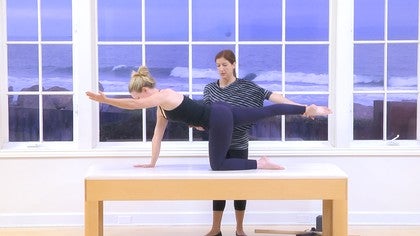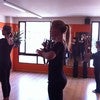Sacroiliac Dysfunction
Sherri Betz
Tutorial 2037
Watch this Tutorial


Gia Calhoun
1 person
likes this.
Marta ~ Thank you for your forum post. If we can add more Spanish subtitles to the site, we will make sure this class is included.
8 years ago
I'm so grateful to have this on film so I have it to refer to in the future!
Amy, I read your comment and it's inspired me to review this again with a lot more attention.
I have a question - do either of you, Sherri or Amy, have any guidance on monitoring the lumbar spine in my own body when I’m working on my own without someone there to palpate? Would you advise putting something under my back to get more direct feedback on my back extensors?
Or do you think that would interfere with using my abdominal engagement for strength? (I'm referring to the toe taps "into the imaginary water" at about 11:40 minutes into the segment)
Thanks for your help!
Amy, I read your comment and it's inspired me to review this again with a lot more attention.
I have a question - do either of you, Sherri or Amy, have any guidance on monitoring the lumbar spine in my own body when I’m working on my own without someone there to palpate? Would you advise putting something under my back to get more direct feedback on my back extensors?
Or do you think that would interfere with using my abdominal engagement for strength? (I'm referring to the toe taps "into the imaginary water" at about 11:40 minutes into the segment)
Thanks for your help!
8 years ago
Hi Maggie,
The best feedback is to place your fingers, palm up on the lumbar spine and gently rest the tips on the vertebrae and the proximal part of your fingers on the erector spinae muscles to palpate for tone. Keep the vertebrae still after you have found your neutral position and the muscles relaxed. Also, you might use something thick, like a fletcher towel underneath the low back to fill up the space if you have a moderate lordosis. if you spine is pretty flat, you would use a thinner strap. You can refer to Tutorial 2816: Supine Mat Modifications. I explain this in more detail in that tutorial.
The best feedback is to place your fingers, palm up on the lumbar spine and gently rest the tips on the vertebrae and the proximal part of your fingers on the erector spinae muscles to palpate for tone. Keep the vertebrae still after you have found your neutral position and the muscles relaxed. Also, you might use something thick, like a fletcher towel underneath the low back to fill up the space if you have a moderate lordosis. if you spine is pretty flat, you would use a thinner strap. You can refer to Tutorial 2816: Supine Mat Modifications. I explain this in more detail in that tutorial.
8 years ago
Thanks Sheri, as always very helpful information! Based on your comments on strengthening only when you have the pelvis balanced - how would you approach a client who is imbalanced because of a scoliosis. I have been using soft wedges as taught by Karina Lineback to get the pelvis more balanced. What say you? I would love to see a video on working with elderly with both scoliosis and osteoporosis.
8 years ago
Hi Betsy,
When someone has long-term compensations due to scoliosis, the pelvic treatment program is quite different. I believe that the internal organs and facial system organizes around the spinal curves. I have seen patients get very flared up with attempts to "fix" the pelvis under a curved spine and the SI ligaments can get strained. I am treating a patient with exactly that condition now. She does great with spinal elongation and core control to support her spine. A teacher must be careful when attempting to correct a pelvic girdle alignment. I would need to perform an in person assessment before making any generic recommendations in someone with both conditions. I would definitely recommend a referral to a physical therapist or osteopath and follow their recommendations for an exercise program.
When someone has long-term compensations due to scoliosis, the pelvic treatment program is quite different. I believe that the internal organs and facial system organizes around the spinal curves. I have seen patients get very flared up with attempts to "fix" the pelvis under a curved spine and the SI ligaments can get strained. I am treating a patient with exactly that condition now. She does great with spinal elongation and core control to support her spine. A teacher must be careful when attempting to correct a pelvic girdle alignment. I would need to perform an in person assessment before making any generic recommendations in someone with both conditions. I would definitely recommend a referral to a physical therapist or osteopath and follow their recommendations for an exercise program.
8 years ago
Thanks Sherri, I will reach out to a local PT with Pilates experience. I have had success with scoliosis clients but they were not so weak, kyphotic and in this case had a compression fracture. It is painful for her to even lie down on her back and get up. Yet she goes dancing twice a week at 83!
8 years ago
Betsy, you have an amazing PT in Denver who is Schroth trained...Lise Stolze. She will be an invaluable resource.
8 years ago
Hi Sherri x listening in on your conversations with Betsy x I agree that each client has to be assessed as a unique and individual case and that you cannot make generic assessments. But do you think that is always safe to work on elongating the spine to relieve tensions building up due to unnatural biases in Scoliosis? My gut says yes but I would like to hear opinion based on your considerable experience in the field.
8 years ago
101-110 of 165
You need to be a subscriber to post a comment.
Please Log In or Create an Account to start your free trial.







































































